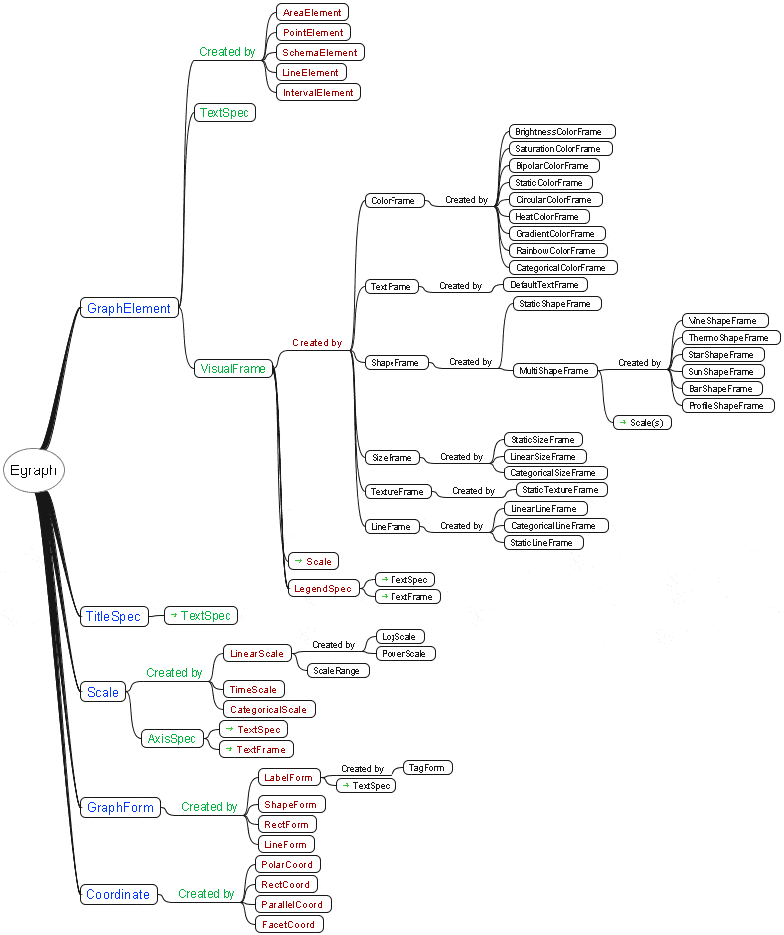Style Chart API - Object Hierarchy
The figure below shows the object structure of the Style Intelligence charting API. Among the significant objects, GraphElement contains the elements that graphically represent data (lines, bars, etc.). VisualFrame contains information about mapping data dimensions to physical properties (size, color, etc.), and Scale contains the scaling information for such mappings. GraphForm contains information for manually-drawn chart objects.

Getting and Setting Chart Properties
The Chart API provides getter and setter methods that allow you to read and write most chart properties from script. This following section provides definitions and examples for the setter methods.
In general, you can call the getter method corresponding to a particular setter method by simply changing the method name prefix. For example, the getter method corresponding to LabelForm.setAlignmentY() is LabelForm.getAlignmentY().
The following script illustrates how you can get the alignment of one chart component, and use it to set the alignment of another:
importPackage(inetsoft.graph)
importPackage(inetsoft.graph.element)
importPackage(inetsoft.graph.scale)
importPackage(inetsoft.graph.aesthetic)
importPackage(inetsoft.graph.data)
importPackage(inetsoft.graph.coord)
importPackage(inetsoft.graph.guide.form)
var arr = [["State","Quantity"], ["NJ",200], ["NY",300]];
dataset = new DefaultDataSet(arr);
graph = new EGraph();
var elem = new IntervalElement("State", "Quantity");
var form1 = new LabelForm();
var form2 = new LabelForm();
form1.setLabel("label1");
form1.setPoint(new java.awt.Point(100, 100));
form1.setAlignmentY(GraphConstants.TOP_ALIGNMENT);
form2.setLabel("label2");
form2.setPoint(new java.awt.Point(200, 100));
form2.setAlignmentY(form1.getAlignmentY());
graph.addForm(form1);
graph.addForm(form2);
graph.addElement(elem);
More Articles About Charting
Amazon.com Seller Metrics - Selling products on Amazon.com involves managing various aspects of your business, from inventory and pricing to customer feedback and sales performance. To effectively monitor and optimize your performance as an Amazon seller, you need to track a range of key metrics. Here are some important metrics that Amazon.com sellers typically monitor: Sales Performance Metrics: Total Sales: The overall revenue generated from selling products on Amazon.com. Sales by Product: Sales performance broken down by individual products or product categories. Sales Velocity: The rate at which your products are selling over a specific period, indicating demand and popularity...
Compliance Operations Dashboards - A Compliance Operations Analyst utilizes performance tracking dashboards as a crucial tool to monitor and analyze compliance-related activities within an organization. These dashboards provide a visual representation of various metrics, key performance indicators (KPIs), and trends, allowing analysts to gain insights into the compliance operations and identify areas for improvement. Here's how a Compliance Operations Analyst can use performance tracking dashboards effectively: Monitoring Compliance Metrics: Dashboards display real-time or near real-time data related to compliance metrics, such as the number of compliance incidents, regulatory violations, or policy breaches. Analysts can monitor these metrics regularly to gauge the overall compliance health of the organization and identify any emerging patterns or issues...
Fast Food Operations Tracking - The manager of fast food operations oversees various aspects of the restaurant's performance to ensure efficiency, quality, and profitability. They track key performance indicators (KPIs) that provide insights into operational effectiveness, customer satisfaction, and financial performance. Here are some common KPIs that a manager of fast food operations might track: Sales Revenue: Total revenue generated from food and beverage sales, including dine-in, drive-thru, and delivery orders. Monitoring sales revenue helps assess the restaurant's overall performance and identify trends in customer demand...
Field Service Dashboard Example - In order to ensure efficient operations, effective customer service, and efficient resource allocation, field service management is essential. Organizations depend on field service dashboards with key performance indicators (KPIs) and analytics to accomplish these goals. These dashboards provide in-the-moment insights into numerous fields operating areas, allowing firms to make fact-based choices. We will examine a full list of KPIs and analytics often used on field service dashboards in this post. First-Time Fix Rate: The proportion of service calls that are resolved during the first visit is tracked by this KPI. High first-time repair rates are a sign of productive field personnel and well-planned schedule, which translate into lower costs and more customer satisfaction...
Report Tool for Pharmacovigilance - Pharmacovigilance is a critical function in the pharmaceutical industry, focusing on the detection, assessment, and prevention of adverse effects or any other drug-related problems. With the increasing complexity of global drug safety regulations and the need for real-time monitoring of drug safety data, VigilantPharma faced several challenges in managing and reporting data effectively. To overcome these challenges, VigilantPharma implemented InetSoft's Customizable Report Tool that provided the flexibility, automation, and integration capabilities necessary for effective pharmacovigilance reporting. The tool allowed VigilantPharma to generate, manage, and share reports tailored to the specific needs of different stakeholders, all while ensuring compliance with regulatory standards.
Safety Regulations Dashboard - The Department of Health and Safety Regulations typically tracks a variety of key metrics on its dashboard to monitor and ensure compliance with health and safety standards, protect public health, and promote workplace safety. Here are some common metrics that may be included on a dashboard maintained by a Department of Health and Safety Regulations: Incident and Injury Rates: Number of Workplace Injuries: Tracking the total number of workplace injuries, including minor injuries, major incidents, and fatalities. Injury Rate: Calculating the rate of injuries per 100 full-time employees or other relevant metrics, providing insights into workplace safety performance...
Water Production Metrics - Drinking water production is a critical public service that ensures the safety, quality, and availability of potable water for communities. To maintain high standards and efficient operations, water production facilities utilize a variety of Key Performance Indicators (KPIs) and metrics. These KPIs and metrics are essential for performance management, helping to monitor and improve processes, ensure regulatory compliance, and enhance service delivery. Below, we delve into some of the most important KPIs and metrics tracked in drinking water production dashboards, along with their definitions and significance. 1. Water Quality Compliance Rate Definition: The percentage of water samples that meet the regulatory standards for drinking water quality over a specific period...
| Previous: Chart Design |
Next: Chart Properties
|